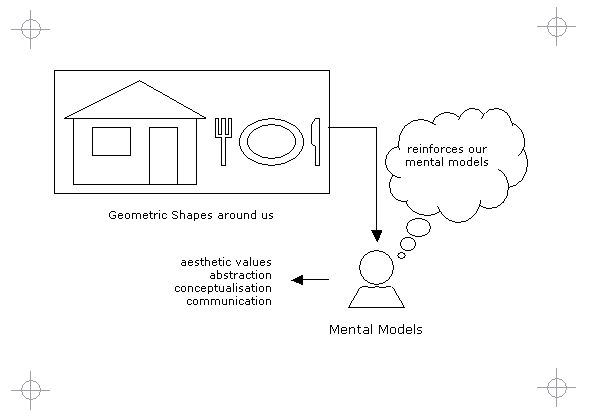|
Diagram
|
|
|

|
|
Title
|
|
|
Shaping the Mind
|
|
Building Architecture
|
|
|
In western society, people take for granted how geometric forms around them help to shape and reinforce their mental models. From rectangular doors and windows to circular plates, our mental models are shaped from our early childhood. Contrast this with cultures that build their homes and surrounds in harmony with the natural world.
|
|
Architecture Intensive Disciplines
|
|
|
Team collaboration in design and construction can be enhanced by our attempting to understand how individuals shape their mental models. What inspires them and how have their values been reinforced. Having this understanding gives us a wider perspective and can enhance the way we design and build.
|
|
Case Study A: Large Corporate IT
|
|
|

|
|
|
Some of my colleagues did not always feel comfortable with being "psycho-analysed" but when the idea was mentioned one or two members in the team would always find this interesting. A good indicator was the way people responded to the visual models. Some members of team would be easily put off with specification documents or diagrams that seemed cluttered.
Technical teams were "geared" for construction. As such if a construction plan was presented and it identified what needed to be done and left room for variation, the team would deliver in record time. If the specification was vague and left too much room for further analysis or required a lot of reading, the team would quickly become frustrated. Mental models needed to be formed. For some it could be tested by drawing a "picture" while for others it was a case of working in close interaction - prototyping or pairing.
|
|
Case Study B: Small Commercial Team
|
|
|

|
|
|
The use of metaphors to communicate a design was interesting and surprisingly effective. But the "talk" had to be made tangible through testing. Sometimes the metaphors were wrong. Understanding people's interests does help. You can draw metaphors from sports, shopping, hobbies, politics and news events. As a team we decided to use natural patterns but would often draw on other things to illustrate an idea. The business analysis specifications were done in a structured manner and through documentation. Usually the functional requirements were straight forward. It was in the underlying technical designs, mechanisms, libraries and system objects where metaphors were used to form mental models.
|
|
|


